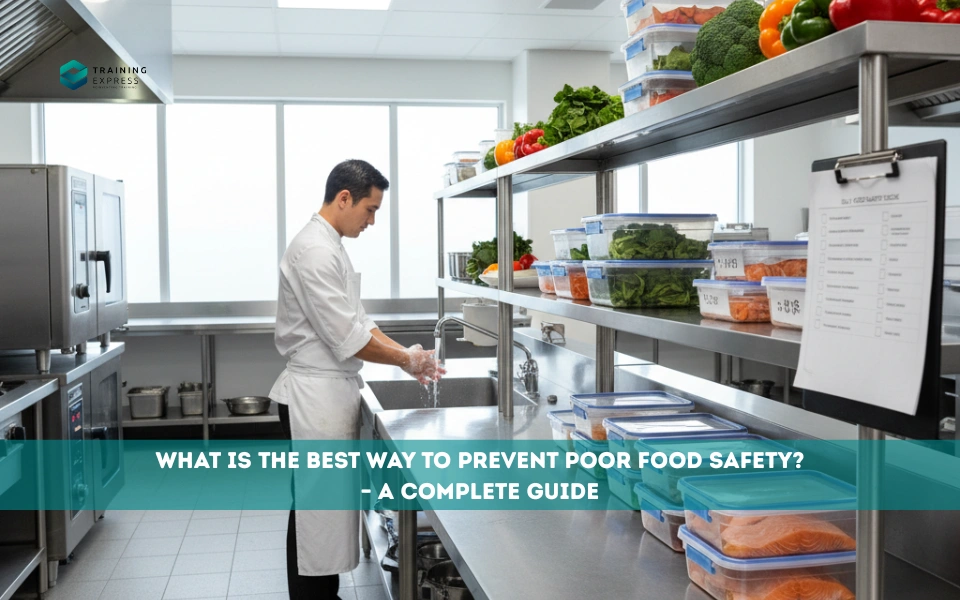
Food is not just fuel; it’s something that connects families, cultures, and even entire communities. But when food safety is ignored, that same food can quickly turn into a threat. According to the World Health Organization (WHO), millions of people suffer from foodborne illnesses every year, many of which could be avoided with simple preventive measures. So, what is the best way to prevent poor food safety? The truth is, there isn’t one magic solution but rather a combination of practices, habits, and systems working together.
This guide dives deep into proven strategies and practical steps to ensure food safety at home, in restaurants, and across the food supply chain. From handwashing and proper storage to advanced systems like HACCP and FSMS, we’ll explore everything you need to know to keep food safe and healthy.
Table of Contents
7 Best Ways to Prevent Poor Food Safety
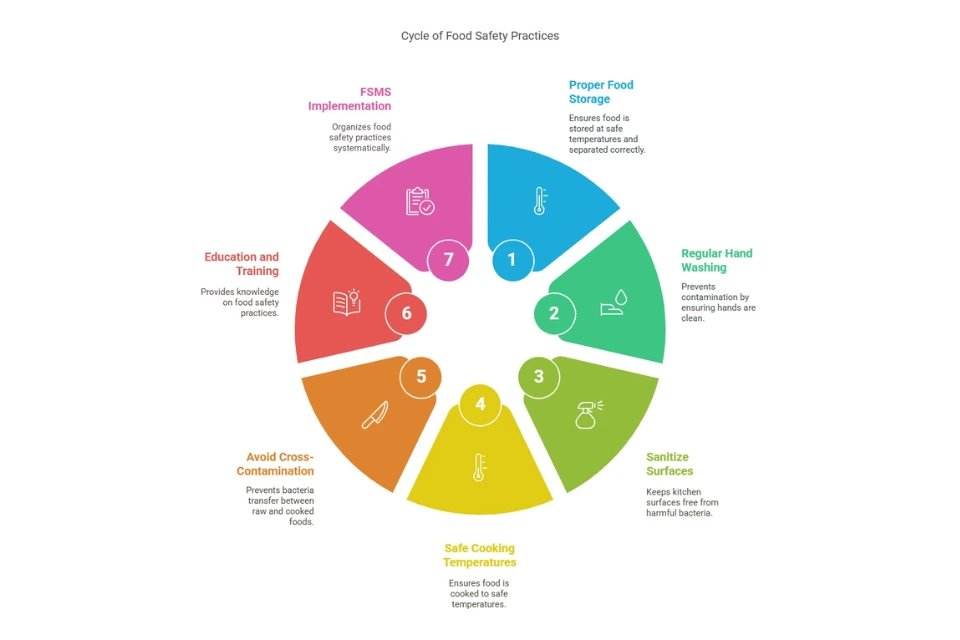
Food safety doesn’t happen by accident; it requires conscious effort, planning, and discipline. Below are the seven best ways to prevent poor food safety practices and reduce the risk of foodborne illnesses.
1. Proper Food Storage
One of the most critical pillars of food safety is proper storage. Many people don’t realize that the way you store your food determines how long it stays safe to eat. Perishable items like meat, poultry, dairy, and seafood require refrigeration at or below 40°F (4°C). Frozen foods must be kept at 0°F (-18°C) or lower to prevent bacterial growth.

Storage is not just about temperature but also about organization. Raw meat should always be placed on the lowest shelf to avoid dripping onto other foods, and dry goods like rice or flour should be sealed in airtight containers to prevent pests and moisture.
Following the FIFO (First In, First Out) rule helps reduce waste and keeps food fresh. In restaurants and food facilities, strict storage rules like humidity control and monitoring systems are in place, since bacteria such as Salmonella and E. coli thrive when food is stored incorrectly. Proper storage, whether at home or commercially, is truly life-saving.
“According to the FDA, “Refrigerators should be kept at or below 40°F (4°C) and freezers at 0°F (-18°C) to slow bacterial growth and keep food safe”
- (FDA, 2023), Food and Drug Administration
2. Regular Hand Washing
Hand washing may seem basic, but it is one of the most powerful defenses against foodborne illnesses. Our hands come into contact with countless germs every day, and without proper hygiene, these can easily transfer to food during preparation or serving.

Washing hands with soap and warm water for at least 20 seconds reduces contamination risks. Critical times to wash include:
- Before preparing or eating food
- After handling raw meat, poultry, or seafood
- After using the restroom
- After touching pets, trash, or dirty surfaces
In restaurants and kitchens, workers must wash hands frequently, sometimes using sanitizers for extra safety, though soap remains essential. Imagine cutting raw chicken and then grabbing a cucumber—without washing, harmful bacteria like Campylobacter can spread instantly. Clean hands, whether at home or in professional kitchens, are the foundation of safe food.
“The WHO emphasizes that “washing hands with soap and water for at least 20 seconds is one of the most effective ways to prevent the spread of foodborne illnesses”
- World Health Organization, responsible for global public health.
3. Sanitize Surfaces and Equipment
Kitchen surfaces and utensils can carry just as many germs as unwashed hands. Cutting boards, knives, countertops, and even sponges can quickly become breeding grounds for harmful bacteria. A single contaminated knife or surface can ruin an entire meal.
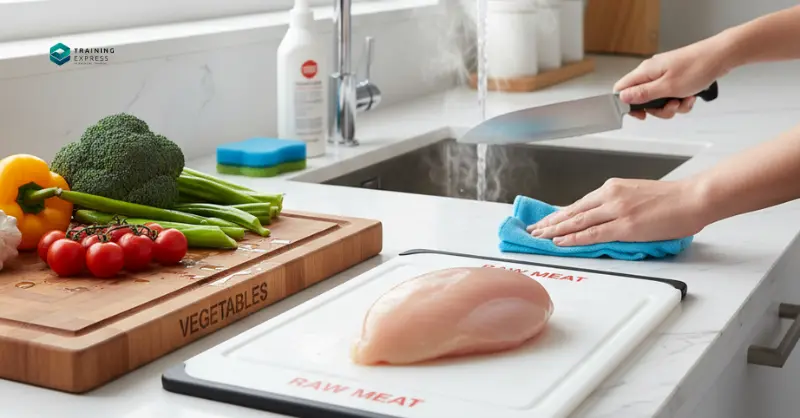
Sanitizing goes beyond wiping with a cloth—it requires disinfectants, food-safe cleaners, or hot water above 170°F (77°C) to kill germs. Different tools need specific care:
- Cutting boards: Use separate ones for raw meat and fresh produce.
- Utensils: Wash right after use, especially between raw and cooked foods.
- Kitchen sponges: Replace often, as they trap bacteria.
- Surfaces: Clean regularly with bleach-based or approved sanitizers.
Restaurants clean equipment multiple times daily because bacteria multiply fast in food prep areas. Even at home, following similar routines can prevent risks. A clean kitchen isn’t just about looks—it stops invisible threats that often cause foodborne illnesses.
“The USDA advises, “All kitchen surfaces, utensils, and cutting boards should be cleaned and sanitized regularly to eliminate harmful bacteria”
- USDA, United States Department of Agriculture
4. Use of Safe Cooking Temperatures
Cooking is not just about taste—it’s also about safety. Proper cooking temperatures ensure that harmful pathogens like E. coli, Listeria, and Salmonella are destroyed before food reaches the table.
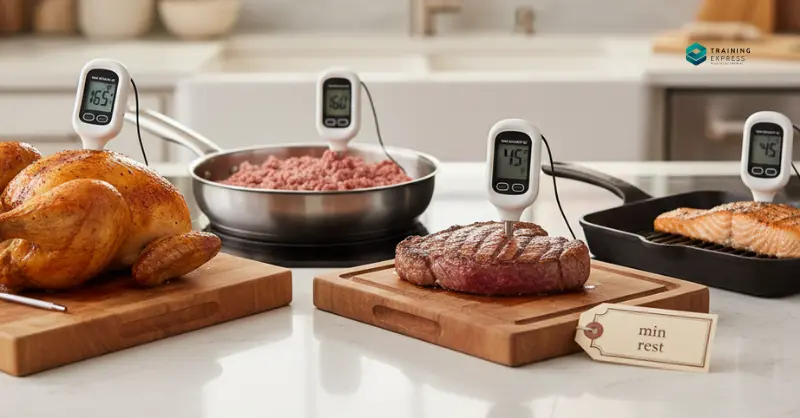
Each type of food has a recommended safe internal temperature:
- Poultry (chicken, turkey): 165°F (74°C)
- Ground meats: 160°F (71°C)
- Beef, pork, lamb (steaks, roasts, chops): 145°F (63°C) with a 3-minute rest
- Fish: 145°F (63°C)
Using a food thermometer is the most reliable way to check doneness. Many people rely on color or texture, but appearances can be misleading. For example, ground beef can turn brown before it’s fully cooked, while chicken might look white but still be undercooked inside.
Safe cooking also includes reheating leftovers to at least 165°F (74°C). Foods kept at room temperature for more than 2 hours (or 1 hour in hot climates) should be discarded, as bacteria multiply rapidly in the “danger zone” between 40°F and 140°F (4°C–60°C).
Cooking food properly is like building a defense shield—it eliminates dangerous bacteria and ensures that every bite is safe.
“The FDA provides guidelines on safe food handling, including proper storage temperatures, avoiding cross-contamination, and the importance of cleaning and sanitizing surfaces.”
- U.S. Food and Drug Administration, FDA Food Safety Basics.
5. Avoid Cross-Contamination
Cross-contamination is one of the most common causes of foodborne illness. It occurs when bacteria from one food transfer to another, often through contact with surfaces, utensils, or hands. The classic example is cutting raw chicken on a board and then using the same board for fresh vegetables without washing it first.

Preventing cross-contamination requires strict separation between raw and cooked foods. Best practices include:
- Using separate cutting boards for raw meat, seafood, and produce.
- Keeping raw and cooked foods in different containers.
- Cleaning knives, plates, and countertops immediately after contact with raw foods.
- Storing raw foods below cooked foods in the refrigerator to prevent dripping.
In restaurants, color-coded cutting boards are often used to avoid confusion—red for meat, green for vegetables, blue for seafood, etc. At home, simply designating one board for meat and another for vegetables can greatly reduce risks.
Cross-contamination can be invisible but deadly. Just a few bacteria transferred from raw meat to salad can cause severe illness. That’s why awareness and prevention are key.
“The FSA highlights the importance of food hygiene practices, including hand washing, cleaning surfaces, and preventing cross-contamination.”
Food Standards Agency (FSA), FSA Food Hygiene.
6. Education and Training
Food safety is more than just following steps—it’s about knowing why those steps matter. Education and training build the foundation for safe practices, whether in households, restaurants, or food processing plants. Many foodborne illnesses come from simple mistakes like not washing hands, undercooking meat, or storing leftovers the wrong way. With proper awareness, these risks can be greatly reduced, which is why training programs such as Food Hygiene and Safety Level 3 are so valuable.

In professional kitchens, food handlers are often legally required to complete certified training. These programs cover key topics like:
- Personal hygiene – how to wash hands, wear gloves, and use protective gear.
- Food handling practices – correct thawing, cooking, and storage methods.
- Hazard identification – recognizing contamination risks.
- Allergen management – preventing accidental exposure to allergens.
Think of food safety training like driver’s education—you wouldn’t hand over a car without lessons, so food shouldn’t be prepared without proper knowledge. Training also needs to be continuous, with refresher courses for staff and lessons at home for children. Knowledge prevents negligence, and the more people learn, the safer food becomes for everyone.
“A case study on a fast-food chain found that after implementing mandatory food safety training, reported foodborne illness incidents dropped by 50% within one year. Before training, 65% of outbreaks were linked to poor food handling. The training covered hygiene, cooking temperatures, and cross-contamination prevention (FDA, 2020).”
7. Food Safety Management System (FSMS)
For large-scale food businesses, a Food Safety Management System (FSMS) is crucial. It’s a structured framework that combines policies, processes, and monitoring to ensure safety from production and storage to preparation and serving.
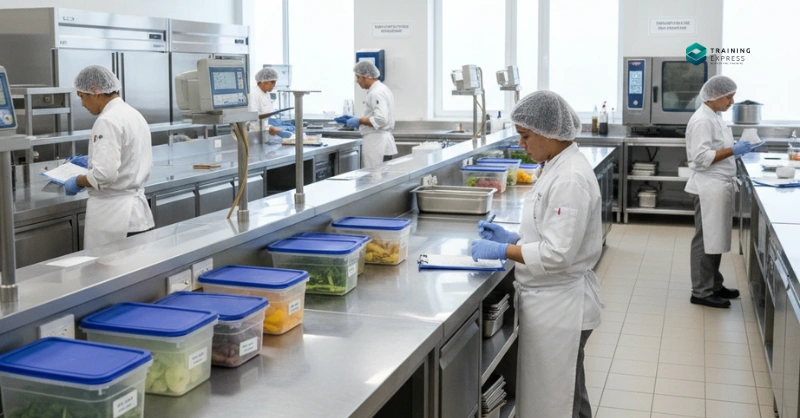
Unlike individual practices, FSMS offers a full system approach. It often includes:
- HACCP principles (Hazard Analysis and Critical Control Points)
- Monitoring tools to track temperatures, cleanliness, and staff compliance
- Documentation systems for audits and inspections
- Corrective actions when something goes wrong (e.g., discarding spoiled products)
In practice, an FSMS could mean microbial testing and equipment checks in factories, or daily checklists in restaurants. It standardizes processes, reduces risks, and prevents costly recalls. Think of it as the “seatbelt” of the food industry—it doesn’t stop accidents but makes food handling much safer.
“The FSMS mentioned in the section aligns with the HACCP principles, which are internationally recognized for managing food safety risks.”
HACCP, FDA HACCP Principles.
What is Food Safety and Hygiene?
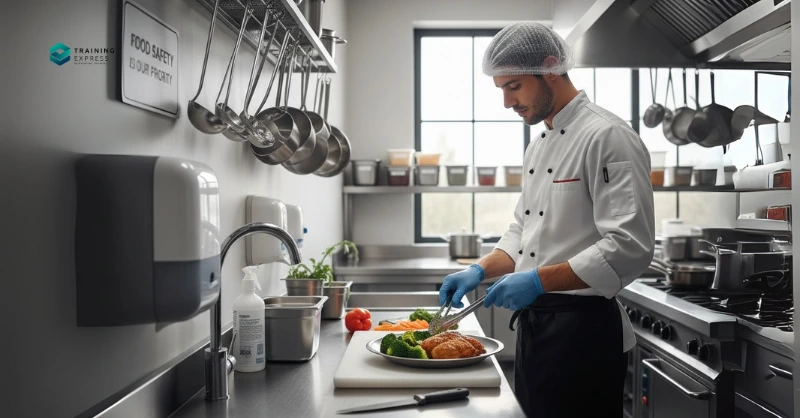
At its core, food safety and hygiene are about preventing foodborne illnesses by reducing contamination risks. The two terms are often used together but have slightly different meanings.
- Food Safety refers to the overall systems, practices, and regulations that keep food safe to eat, including cooking, handling, packaging, and distribution.
- Food Hygiene focuses on daily cleanliness and sanitation practices like washing hands, cleaning utensils, sanitizing surfaces, and controlling pests.
These two go hand in hand because contamination can happen anywhere in the food chain—from farms to kitchens. They not only prevent food poisoning but also protect vulnerable groups and ensure businesses meet legal standards. Simply put, food safety is the “big picture,” while hygiene is the “day-to-day practice,” and together they protect us at every meal.
Essential Tools to Prevent Poor Food Safety Issues
To effectively manage food safety, businesses and households need structured tools and programs that go beyond basic practices. These tools provide a roadmap for identifying risks, managing them, and ensuring consistency.
HACCP (Hazard Analysis Critical Control Point)
HACCP is one of the most widely recognized food safety systems in the world. It focuses on identifying specific hazards in the food production process and implementing measures to control them. The goal is to prevent problems before they occur rather than simply reacting afterward.
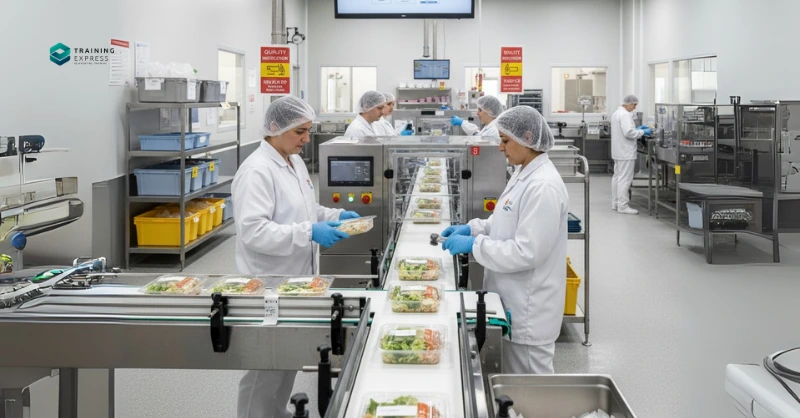
The system follows seven key principles:
- Conduct hazard analysis.
- Identify critical control points (CCPs).
- Establish critical limits.
- Set up monitoring procedures.
- Determine corrective actions.
- Verify the system is working effectively.
- Keep proper records and documentation.
For example, in a meat processing plant, HACCP might identify cooking as a critical control point. The critical limit could be a minimum temperature of 165°F (74°C). Workers would then monitor temperatures, record results, and take corrective action (like re-cooking) if limits aren’t met.
By following HACCP, businesses can systematically reduce food safety risks while proving compliance during inspections.
Prerequisite Programs
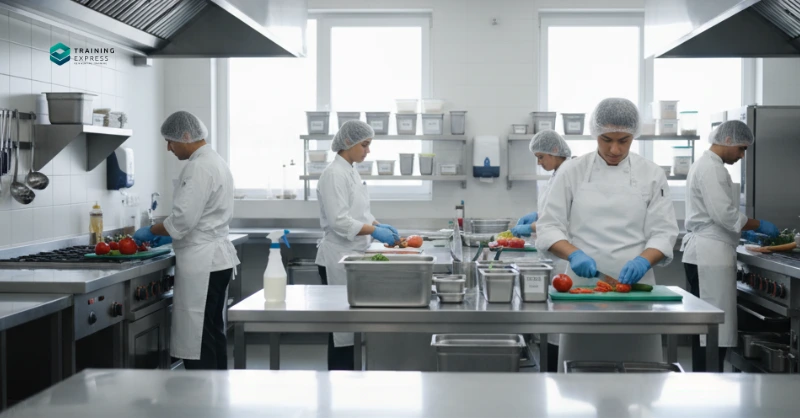
Before HACCP can be implemented, prerequisite programs (PRPs) must be in place. These are the foundation of good food handling and hygiene practices. Without them, HACCP cannot function effectively.
Some common PRPs include:
- Good Manufacturing Practices (GMPs) – Ensuring clean facilities, pest control, and equipment maintenance.
- Personal Hygiene Programs – Training employees in handwashing, protective clothing, and illness reporting.
- Sanitation Standard Operating Procedures (SSOPs) – Step-by-step cleaning and disinfection routines.
- Supplier Control Programs – Ensuring raw materials are sourced from safe, approved suppliers.
Think of PRPs as the “basic building blocks” of food safety. They may not directly target specific hazards, but they create an environment where hazards are less likely to occur in the first place.
Food Safety Management System (FSMS)

As mentioned earlier, an FSMS ties everything together. While HACCP and PRPs address specific areas, an FSMS integrates them into a complete framework. It ensures that food safety isn’t just about isolated practices but a cohesive, company-wide culture.
Modern FSMS programs often use digital solutions, like automated temperature monitoring, cloud-based documentation, and real-time alerts when critical limits are breached. This level of technology makes it easier for businesses to stay compliant and proactive.
For small businesses and households, FSMS might be less formal but equally important. A family kitchen can have its own “mini FSMS” by setting clear routines for storage, cleaning, and cooking.
Which is a Correct Food Safety Practice?
With so many guidelines, it can sometimes feel overwhelming to know which practices truly make a difference. The simplest way to think about it is: correct food safety practices are those that reduce contamination risks and keep food safe at every stage.

Examples include:
- Washing hands before handling food.
- Cooking meat to safe internal temperatures.
- Separating raw and cooked foods.
- Storing perishables in the refrigerator promptly.
- Using clean utensils and sanitized surfaces.
Incorrect practices, on the other hand, include thawing food at room temperature, reusing dirty sponges, or tasting food to check if it’s still safe. These habits might seem harmless but can easily lead to illness.
Correct food safety practice is not just a checklist—it’s a mindset. The goal is to treat food with respect and recognize that even small oversights can have big consequences.
Why is FATTOM Important to Food Safety?

When it comes to food safety, understanding FATTOM is like knowing the “enemy’s playbook.” FATTOM is an acronym that describes the six conditions bacteria need to grow: Food, Acidity, Time, Temperature, Oxygen, and Moisture.
- Food – Bacteria thrive on nutrients found in common foods like meat, dairy, rice, and cooked vegetables. The more nutrient-rich the food, the faster bacteria can multiply.
- Acidity – Foods with low acidity (like meat and dairy) are more prone to bacterial growth compared to high-acid foods (like citrus fruits and vinegar-based pickles).
- Time – Bacteria can double every 20 minutes under ideal conditions. That’s why leaving food out too long creates a breeding ground for pathogens.
- Temperature – The “danger zone” is between 40°F (4°C) and 140°F (60°C). Within this range, bacteria multiply rapidly.
- Oxygen – Some bacteria need oxygen (aerobic), while others thrive without it (anaerobic), such as Clostridium botulinum which causes botulism.
- Moisture – High moisture content provides an ideal environment for bacterial growth, which is why dry foods like rice or beans have longer shelf lives.
So why is FATTOM important? Because it helps us understand exactly how to control bacterial growth. If we can remove or limit just one of these conditions, bacteria cannot multiply as quickly. For instance, refrigeration controls temperature, drying removes moisture, and pickling increases acidity.
By keeping FATTOM in mind, food handlers can anticipate risks and take proactive steps to minimize them. It’s essentially a roadmap for food safety.
What Food Items Need Time and Temperature Control for Safety?
Not all foods pose the same risk for bacterial growth. Certain foods are classified as TCS foods (Time/Temperature Control for Safety) because they are especially vulnerable to contamination. These foods require strict handling, storage, and cooking guidelines to stay safe.
Meat and Poultry
Raw and cooked meat and poultry are among the highest-risk foods. They are protein-rich, moist, and often stored in bulk, making them a perfect environment for bacteria like Salmonella, E. coli, and Listeria.

Key safety tips include:
- Refrigerate or freeze immediately after purchase.
- Thaw safely in the refrigerator, not on the counter.
- Cook poultry to 165°F (74°C) and ground beef to 160°F (71°C).
- Avoid partial cooking, as it allows bacteria to survive and multiply.
Even cooked meat can be dangerous if left at room temperature for too long. Leftovers should always be cooled quickly and stored in airtight containers.
Dairy Products
Milk, cheese, yogurt, and cream-based foods fall under TCS because they are low in acidity and high in moisture. Dairy is particularly prone to contamination by Listeria monocytogenes, which can grow even at refrigeration temperatures.

Best practices include:
- Keeping milk refrigerated at or below 40°F (4°C).
- Consuming dairy before the expiration date.
- Avoiding unpasteurized dairy products, which carry a higher risk of harmful bacteria.
Soft cheeses like feta and brie are more vulnerable than hard cheeses due to their higher moisture content. This makes handling and storage extra critical.
Eggs
Eggs are another TCS food that requires careful handling. While the shell protects the egg, it isn’t foolproof. Bacteria like Salmonella can contaminate both the shell and the inside of the egg.

Safety measures include:
- Storing eggs in the refrigerator, not at room temperature.
- Cooking eggs until both the yolk and white are firm.
- Avoiding recipes with raw eggs (like homemade mayonnaise or raw cookie dough), unless pasteurized eggs are used.
Restaurants and bakeries often rely on pasteurized liquid eggs to reduce contamination risks. At home, simple habits like washing hands after handling eggshells can prevent cross-contamination.
Cooked Foods

Ironically, once food is cooked, it becomes more vulnerable to bacterial growth if not handled correctly. This is because cooking removes natural protective barriers and adds moisture.
Examples include:
- Cooked rice and pasta, which can harbor Bacillus cereus.
- Soups and stews, which retain heat but can stay in the danger zone if not cooled quickly.
- Leftovers that sit out for more than 2 hours.
To stay safe:
- Cool cooked foods rapidly (use shallow containers for faster cooling).
- Reheat leftovers to 165°F (74°C) before serving.
- Never reheat food more than once, as repeated heating and cooling cycles increase bacterial risks.
Cooked foods may seem harmless, but improper storage and reheating can make them just as dangerous as raw foods.
Final Words
Food safety isn’t optional—it’s a responsibility. Whether at home, in a restaurant, or in a factory, the goal is the same: to prevent foodborne illnesses and protect health. From proper storage, hand hygiene, and sanitization to advanced systems like HACCP, FSMS, and PRPs, every step matters.
By understanding concepts like FATTOM and recognizing high-risk foods, we gain the knowledge needed to make safer choices every day. Simple habits—washing hands, separating raw and cooked foods, and using thermometers—can save lives.
Food safety is like building a chain. Each link—storage, handling, cooking, cleaning—must be strong, because one weak link can break the whole system. By applying the best practices outlined in this guide, we create a culture of safety where good food remains good for our health.
Frequently Asked Questions (FAQs)
What is the role of a Food Safety Officer?
A Food Safety Officer is responsible for ensuring that food businesses follow hygiene and safety regulations to protect public health. Their role includes inspecting food establishments, identifying potential hazards, enforcing food safety laws, and providing guidance on best practices. They also investigate foodborne illnesses and take action against businesses that fail to meet safety standards.
What is a food handler's duty regarding food safety?
A food handler’s main duty is to ensure that food is prepared, stored, and served safely to prevent contamination and foodborne illnesses. This includes maintaining personal hygiene, washing hands regularly, wearing clean protective clothing, and handling food at the correct temperatures. They must also follow proper cleaning procedures, avoid cross-contamination, and comply with food safety regulations. By following these practices, food handlers help maintain high hygiene standards and protect public health.
Which is a correct food safety practice?
A correct food safety practice is to always wash your hands with soap and warm water for 20 seconds before and after handling food. Don’t cross-contaminate by keeping raw meat, poultry, fish, and their juices away from other food. After cutting raw meats, be sure to wash the cutting board, knife, and countertops with hot, soapy water. Storing food at the right temperature also helps prevent bacteria growth. Following these steps ensures your food stays safe and reduces the risk of foodborne illness.
What is the purpose of a food safety management system?
The purpose of a food safety management system (FSMS) is to ensure that food is prepared, stored, and served in a way that prevents foodborne illnesses and contamination. It helps businesses identify potential hazards, control risks, and maintain high hygiene standards. An FSMS provides guidelines for safe food handling, from sourcing ingredients to serving meals. By implementing an FSMS, food businesses can improve food quality, protect public health, and comply with safety regulations, ultimately ensuring that customers receive safe and healthy food.
Which food safety practice will help prevent foodborne illness?
One of the best food safety practices to prevent foodborne illness is washing your hands with soap and warm water for at least 20 seconds before and after handling food. This helps remove harmful bacteria. Another key practice is to store food at the correct temperature, especially perishable items like meat, dairy, and eggs, to stop bacteria from growing. Additionally, keeping raw meat separate from other foods, and thoroughly cleaning surfaces, utensils, and cutting boards after preparing raw food will also help reduce the risk of contamination.
How can I get a food safety certificate?
To get a food safety certificate, you need to complete a Level 2 food hygiene and safety course and you’ll get a free CPD accredited food safety certificate. This certificate proves you have the knowledge to handle food safely and follow hygiene standards, making it a valuable qualification for anyone working in the food industry.
How do I purchase this course?
1. Click on ‘Take This Course’ button, and you will be directed to your Cart.
2. You can update the course quantity and remove any unwanted items in the Cart, and after that, click on the ‘Checkout’ option and enter your billing details.
3. Once the payment is made, you will receive an email with the login credentials, and you can start learning after logging into the portal.
You can take this course or find any course from the Courses section of our website.
What is the average salary for a Level 2 Food Hygiene and Safety professional in the UK?
The average salary for someone with a Level 2 Food Hygiene and Safety qualification in the UK typically ranges from £18,000 to £25,000 per year. However, the exact figure can vary depending on factors such as location, industry, and level of experience. Those working in larger organisations or in specific sectors, such as food production or hospitality management, may earn higher salaries.
- Available Courses
- Animal care10
- Design28
- Training9
- Accounting & Finance Primary50
- Teaching & Academics Primary37
- Teaching23
- Quality Licence Scheme Endorsed181
- Law10
- IT & Software229
- Job Ready Programme52
- Charity & Non-Profit Courses28
- HR & Leadership4
- Administration & Office Skills4
- Mandatory Training36
- Regulated Courses4
- AI & Data Literacy24
- Health and Social Care290
- Personal Development1630
- Food Hygiene119
- Safeguarding80
- Employability288
- First Aid73
- Business Skills295
- Management425
- Child Psychology40
- Health and Safety533
- Hospitality28
- Electronics31
- Construction63
- Career Bundles201
- Marketing39
- Healthcare172

 Food Hygiene
Food Hygiene Health & Safety
Health & Safety Safeguarding
Safeguarding First Aid
First Aid Business Skills
Business Skills Personal Development
Personal Development



